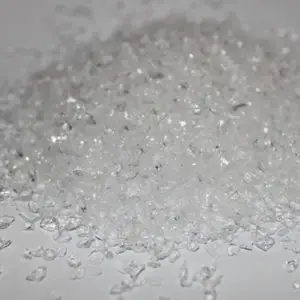Silicon Dioxide
SiO2, known as silica, is a chemical compound that can be found in the nature as sand or quartz.

Silicon Dioxide Specifications
| Shape | Color | Purity | Package | Storage | ||
|---|---|---|---|---|---|---|
| Crystal | Granule | 1-3 mm; 3-5 mm | Colorless Transparent | 99.9% 99.95% 99.99% | 1 Kg/Bag | Avoid exposure to sunlight & acid Keep dry |
| Pillar | e.g.: 2×4 mm | |||||
| Cutting piece | e.g.: 20×10 mm | |||||
Characteristics of Silicon Dioxide
| CAS Number | Density (g/cm3) | Boiling point (Cº) | Melting point (Cº) | Refractive index at 550 (nm) | Transparency range (µm) | Evaporation source |
|---|---|---|---|---|---|---|
| 7631-86-9 | 2.2 | 2950 | 1700 | 1.45-1.46 | 0.2-9 | E |
| Applications | AR coating: Cold light coating; Filter; Insulating coating; Glass coating; UV coating | |||||
Evaporation technique of Silicon Dioxide (SiO2)
Electron beam evaporation works well for optical SiO2 because of its refractive index and it is evaporated from a graphite or tantalum crucible liner. Films result to be smooth and amorphous with good adhesion.
Silicon Monoxide (SiO)
Silicon Monoxide (SiO) is an amorphous solid, available in many forms. It is a highly desirable coating material due to its high deposition rate and ease of evaporation using low cost resistance-heated coating systems.
Specifications of Silicon Monoxide
| Shape | Color | Purity | Package | Storage | ||
|---|---|---|---|---|---|---|
| Sinter | Blocky | 1-40 mm Upon demand | Black | 99.99% | 1 Kg/Bag | Avoid exposure to sunlight & acid Keep dry |
| Granule | 1-3 mm; 3-5 mm | |||||
| Cuboid piece | 100x100x50 mm | |||||
| Tablet | 28×10 mm, 18×10 mm | |||||
Characteristics of Silicon Monoxide
| CAS Number | Density (g/cm3) | Boiling point (Cº) | Melting point (Cº) | Refractive index at 550 (nm) | Transparency range (µm) | Evaporation source |
|---|---|---|---|---|---|---|
| 10097-28-6 | 2.13 | 1880 | 1700 | 1.8-1.9 | 0.4-9 | B (Ta, Mo, W) |
| Applications | Cold light coating; Decorative coating; Protective coating | |||||
Silicon Monoxide Evaporation technique
Resistance heating in baffle boats is the most common evaporation method used, but electron beam evaporation may also be used, particularly with tablets.
